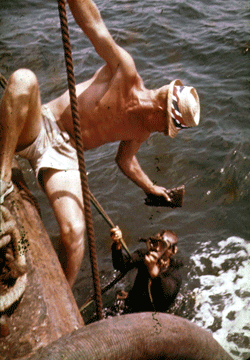Fifty years after they were salvaged and placed in wet storage, the contents of a Confederate blockade runner have reemerged

In 1962, divers from
the U.S. Navy salvaged
artifacts from Modern Greece, a Civil War
blockade runner. The
frogmen hand up a
part of a gun stock.
(Courtesy North Carolina Department of Cultural Resources)
The freighter made its way,
under cover of night in June
1862, toward Wilmington
Harbor in North Carolina.
In its cargo hold were barrels,
boxes, and bundles tightly
layered with rifles, ammunition, tools, tin
and lead ingots, and medical supplies needed
by the Confederate army. The ship, Modern Greece, also carried flatware, plates, and liquor
for the civilian market.
Just before dawn, as Modern Greece attempted
to sneak past the Union blockade of the port,
it ran aground about three-quarters of a mile
offshore, near Fort Fisher. Rebel soldiers from
the fort salvaged what they could—especially the
liquor, arms, and cannon—but faced constant
fire from Union ships. Before long, the remains
of the blockade runner, and what was left of its
cargo, had slipped beneath the waves.
Modern Greece lay buried on the seafloor for
100 years, until 1962, when local divers led U.S.
Navy frogmen on leave to the ship after a spring
nor'easter had uncovered its wreck. The state of
North Carolina invited the frogmen to salvage
the ship, and over the next few weeks they raised guns, knives, and household goods, many still in
their original, though deteriorated, packaging.
The waterlogged artifacts were rushed into tubs
and sinks in local homes.
At that time there were few techniques beyond rinsing and wet storage for the conservation
and long-term preservation of artifacts that
had spent so much time in salt water. Further,
there were far more recovered items than the
state could handle. Some items, such as a few
Enfield rifles, Bowie knives, surgical instruments,
and tools, were treated and displayed, generating
tremendous public interest. But the rest of the
wreck's thousands of artifacts were moved to a
makeshift storage facility—several water-filled
containers open to the elements. Over time,
these holding tanks accumulated organic matter
that decayed into thick
sediment. The cargo of
Modern Greece remained
there until now, waiting
for a second excavation.

To read more, find ARCHAEOLOGY in your local newsstand or bookstore, or click here to buy a copy of the issue online. And if you'd like to receive ARCHAEOLOGY in your mailbox, click here to subscribe.
Marion Blackburn is a freelance writer based in Greenville, North Carolina.

